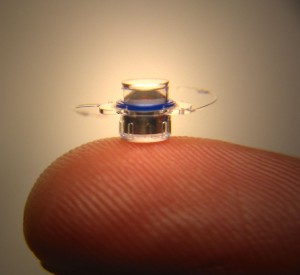The Macular Degeneration Partnership, a program of the Discovery Eye Foundation, has received numerous questions about the implantable miniature telescope (IMT) since it was approved by the FDA in 2010. 
Specifically, the telescope implant uses micro-optical technology to magnify images which would normally be seen in your “straight ahead,” or central, vision. The images are projected onto the healthy portion of the retina not affected by the disease, making it possible for patients to see straight ahead. The procedure is performed on one eye only, and involves removing the eye’s natural lens and replacing it with the tiny telescope implant. This is similar to the surgery performed to remove a cataract, which is a clouding of the natural lens. The other eye remains as is to preserve peripheral vision, which is important for balance and orientation. The surgery is done in an outpatient setting by a specially-trained ophthalmologist called a cornea/cataract surgeon. The telescope implant is FDA approved and available through Medicare.
Although the telescope implant is not a cure for AMD, studies showed that in general patients were able to see 3 to 4 lines better on the eye test chart and demonstrated improved quality of life on the National Eye Institute Visual Functioning Questionnaire. Two multi-year clinical studies enrolled over 225 patients to evaluate the safety and efficacy of the telescope implant used in the CentraSight treatment program. To be considered a candidate for the telescope implant, an ophthalmologist must first confirm that you:
• Have irreversible, End-Stage AMD resulting from either dry or wet AMD
• Are no longer a candidate for drug treatment of your AMD
• Have not had cataract surgery in the eye in which the telescope will be implanted
• Meet age, vision, and cornea health requirements
Some people with end-stage AMD may not be a candidate for a telescope implant. Patients and their physicians will assess if the benefits of the procedure outweigh the potential risks to decide if this treatment option is right for them.
CentraSight is the program that guides people with end-stage AMD through the telescope implant evaluation, surgery and rehabilitation process. While the out-patient procedure is quick, patients also must commit to a comprehensive occupational therapy program to learn how to use their new vision (and way of seeing) in daily life. Click here to watch a video that shows how the implantable telescope works.
“After surgery, one of the most important aspects of the telescope implant procedure is the rehabilitation,” said Dr. Marjan Farid, Associate Clinical Professor of Ophthalmology at the University of California-Irvine School of Medicine. “Specially trained optometrists and occupational therapists work with patients to teach them how to use their new vision because there are different techniques involved when you are sitting still (for example, reading or watching TV) than when you are moving around, such as walking or cooking.”
The CentraSight treatment program is coordinated by retina specialists who treat macular degeneration and other back-of-the-eye disorders. Before deciding to have the surgery, a special vision test is given in the office. A device simulates what a person may expect to see once the telescope is implanted to determine if the potential improvement will meet the patient’s expectations. Once the telescope has been implanted by an eye surgeon, the patient will need to work with vision rehabilitation specialists (approximately 6 to 12 weeks) to learn how to use their new vision in their everyday activities. Risks include all those associated with cataract surgery, such as postoperative inflammation, raised intraocular pressure, corneal swelling, and the potential for comprised corneal health.
“The first patient whom I implanted with this telescope over a year and a half ago states that she can now recognize the faces of her children and grandchildren,” said Dr. Farid. “For patients with AMD, face recognition of loved ones is a major improvement in the overall quality of their life.”
CentraSight treatment centers are available across the nation. Patients can call 1-877-99-SIGHT to find one in their area.
 Judith Delgado
Judith Delgado
Executive Director
Macular Degeneration Partnership

